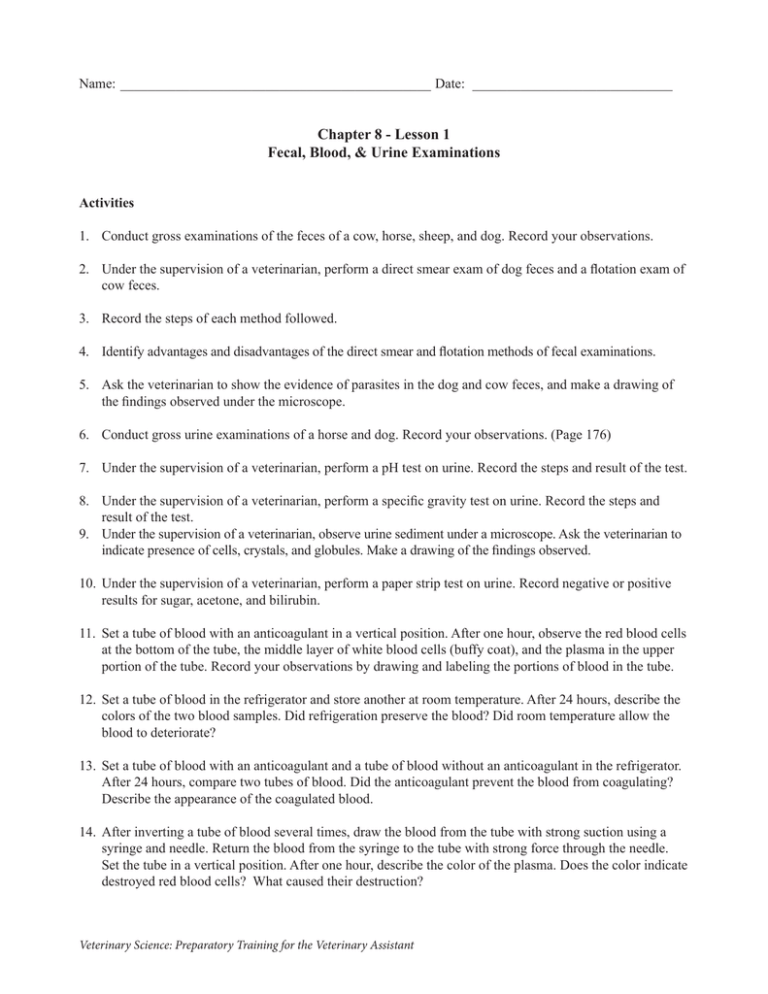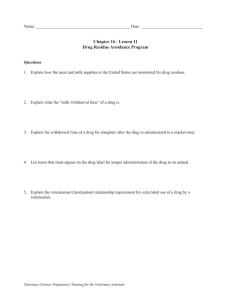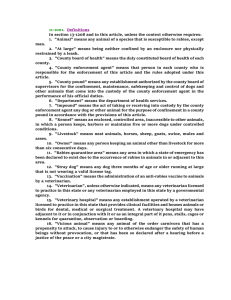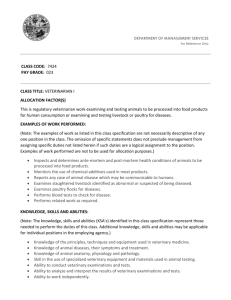Chapter 8 - Lesson 1 Fecal, Blood, & Urine Examinations
advertisement

Name: ______________________________________________ Date: ______________________________ Chapter 8 - Lesson 1 Fecal, Blood, & Urine Examinations Activities 1. Conduct gross examinations of the feces of a cow, horse, sheep, and dog. Record your observations. 2. Under the supervision of a veterinarian, perform a direct smear exam of dog feces and a flotation exam of cow feces. 3. Record the steps of each method followed. 4. Identify advantages and disadvantages of the direct smear and flotation methods of fecal examinations. 5. Ask the veterinarian to show the evidence of parasites in the dog and cow feces, and make a drawing of the findings observed under the microscope. 6. Conduct gross urine examinations of a horse and dog. Record your observations. (Page 176) 7. Under the supervision of a veterinarian, perform a pH test on urine. Record the steps and result of the test. 8. Under the supervision of a veterinarian, perform a specific gravity test on urine. Record the steps and result of the test. 9. Under the supervision of a veterinarian, observe urine sediment under a microscope. Ask the veterinarian to indicate presence of cells, crystals, and globules. Make a drawing of the findings observed. 10. Under the supervision of a veterinarian, perform a paper strip test on urine. Record negative or positive results for sugar, acetone, and bilirubin. 11. Set a tube of blood with an anticoagulant in a vertical position. After one hour, observe the red blood cells at the bottom of the tube, the middle layer of white blood cells (buffy coat), and the plasma in the upper portion of the tube. Record your observations by drawing and labeling the portions of blood in the tube. 12. Set a tube of blood in the refrigerator and store another at room temperature. After 24 hours, describe the colors of the two blood samples. Did refrigeration preserve the blood? Did room temperature allow the blood to deteriorate? 13. Set a tube of blood with an anticoagulant and a tube of blood without an anticoagulant in the refrigerator. After 24 hours, compare two tubes of blood. Did the anticoagulant prevent the blood from coagulating? Describe the appearance of the coagulated blood. 14. After inverting a tube of blood several times, draw the blood from the tube with strong suction using a syringe and needle. Return the blood from the syringe to the tube with strong force through the needle. Set the tube in a vertical position. After one hour, describe the color of the plasma. Does the color indicate destroyed red blood cells? What caused their destruction? Veterinary Science: Preparatory Training for the Veterinary Assistant Gross Examination of Feces Cow Horse Sheep Dog Debris Mucus Blood Color Consistency Gross Urine Examinations Horse Color Odor Consistency Veterinary Science: Preparatory Training for the Veterinary Assistant Dog



